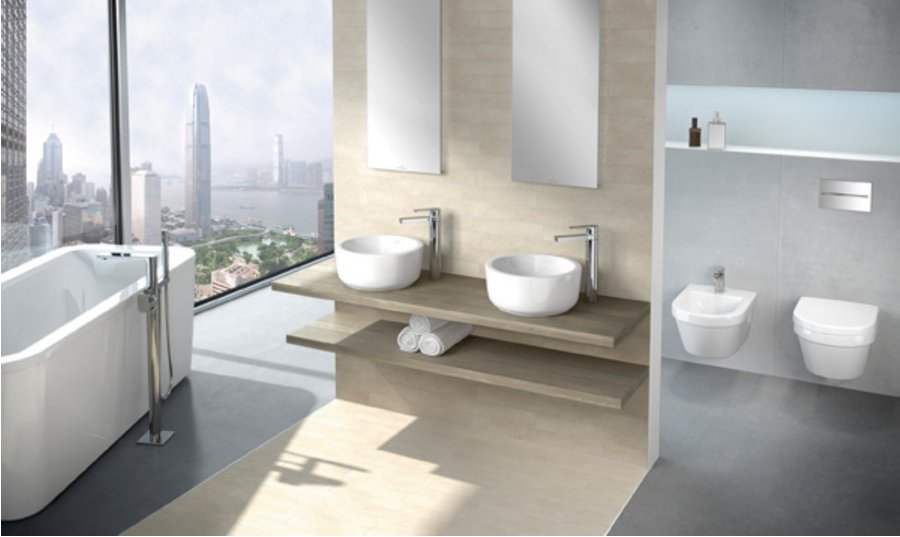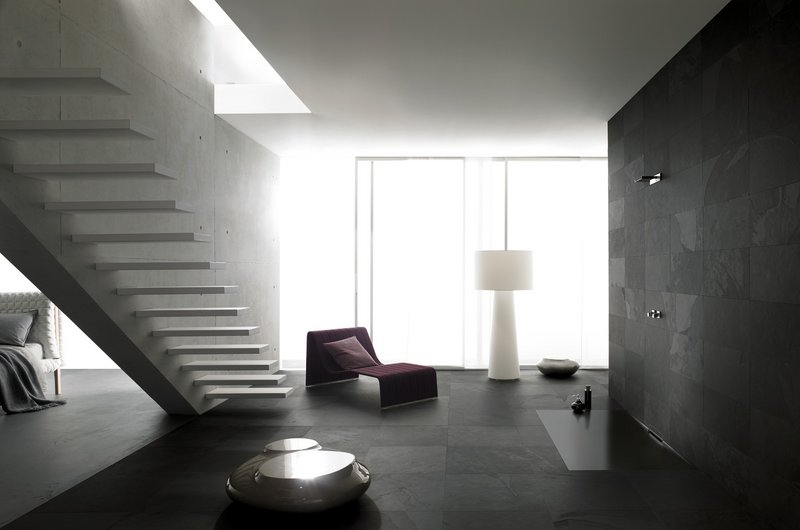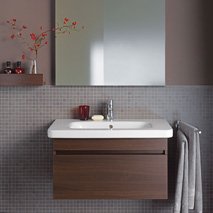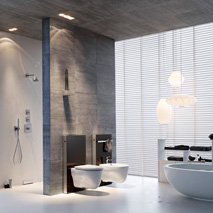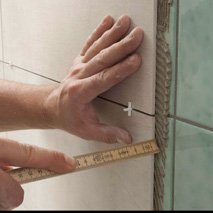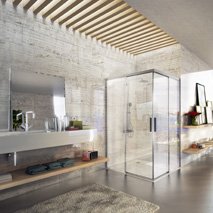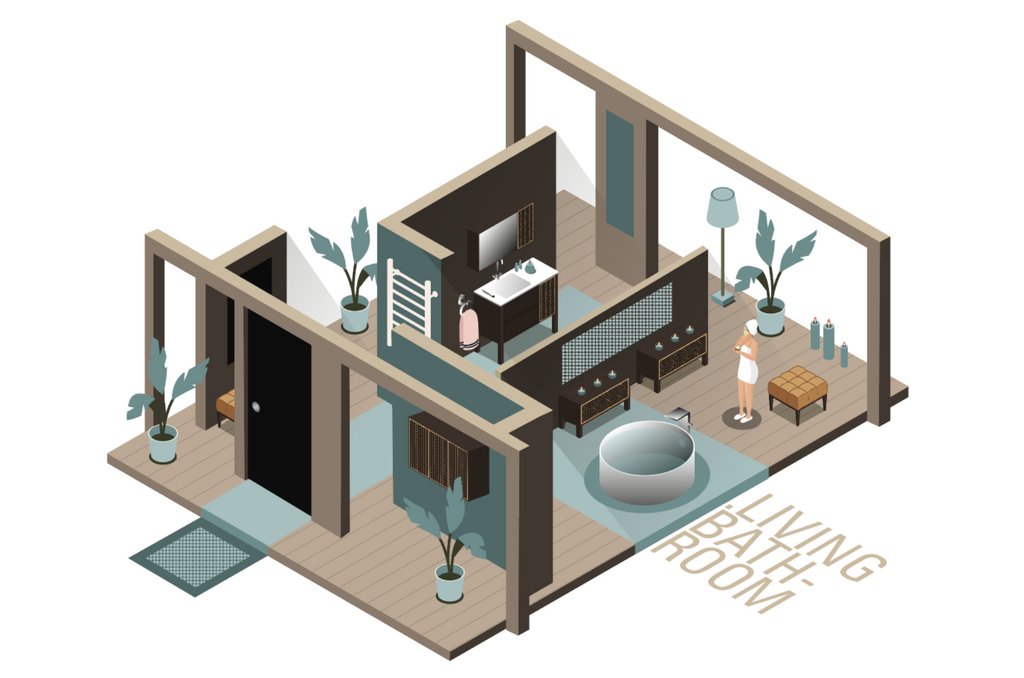Today's notion of the "wellness" concept certainly wasn't familiar back then. And yet Roman bath complexes decorated with ceramic mosaics unquestionably served the very same purpose that the private bathroom was intended to fulfil later on. The history of these bathrooms through the centuries is decidedly chequered and ranges from "non-existent" all the way to opulent amusement centres. But that's another story. What has survived is a preference for the modern equivalent of the fi red and decorated clay slabs of old – today's ceramic tiles – even though it hasn't always been a question of preference so much as of expedience. To this day, the glazed surface is considered a practical covering for walls and floors in spaces that involve dealing with water. For a long time, the design was beside the point. There are for instance many bathrooms from the Art Nouveau era, a time when the building world was bursting with the desire to decorate, with walls covered in pure white tiles, even though there was certainly no shortage of beautifully decorated specimens at the time. It's just that, for the most part, people obviously thought they would be wasted on the bathroom.
Only in the years of economic recovery that followed World War II did mass-produced decorative tiles start to find enthusiastic fans and experience a genuine boom. Tile layers, the kings of the building site in that era, propagated floor-to-ceiling tiles for the bathroom – and would have dearly loved to tile the ceiling as well, if it hadn't been for the risk of the room mutating into a stalactite cave. Nowadays the ceramic tile has long since risen above its former image as a "square, practical, low-maintenance" option – even though, except for "square", all the other attributes certainly still apply. The variety of formats and decors available today make this building material one of the most versatile design elements there is – especially in the bathroom, where it isn't just a case of withstanding the permanent moisture, but of keeping pace with the design dominance of sanitaryware producers as well.
The range of tiles available from manufacturers is meanwhile so diverse and diff erentiated that prominent interior decorators advise anybody planning a new bathroom to make the overall impression of the room their first priority rather than choosing the sanitaryware first, as is usually the case. The guiding principle: less is more. For thanks to state-of-the-art decoration techniques, the tile industry is wallowing in colours and decors. And yet, especially in the bathroom, timelessness is key. That's why careful planning is so essential. In addition, the perfect computer programmes now available for planning bathrooms mean it is possible to get a precise impression of the finished room and the design of its walls before work gets underway – and thus avoid unpleasant surprises later on.
That particularly applies to those renovating an existing bathroom. A consolation for anybody who detests having a building site in the house: the tile industry has set new standards in this respect – in a very literal sense. "Renovation tiles", for instance, are only approx. 5 mm thick and can be stuck onto an old subsurface without any problem. As long as they are professionally laid and only have to withstand moderate loads, they are even suitable for floors and are meanwhile available in a wide range of formats and decors. The advantage: the bathroom is only out of action for a short time.
For those who want more, there is of course a wider range of possibilities to choose from. Although that means the bathroom will be more of a building site until the work is completed, the finished result is like a new build. While he's at it, the bathroom renovator can use this opportunity to think about a level-access shower – a feature that tops many people's wish list nowadays. And not only as a wise precaution for later on, when they might suffer from impaired mobility, but simply because it's such a smart thing to have. Even small bathrooms look far more spacious when the shower merges with the floor, and today's systems even provide solutions for shallow floor constructions.
It is important not to get confused by the various competing systems. Sanitaryware manufacturers are offering ultra flat shower trays and wooing consumers with their hygiene benefi ts, easy cleaning and watertight properties. And yet tiled shower floors are every bit their equal. Competently installed with a certified substructure, they already have the required gradient and are a safe bet in terms of being watertight. The glazed tile surfaces are hygienic and easy to clean as well. Thanks to today's premium grouts, there's no longer any need to worry about the joints becoming a breeding ground for germs and mould. As a result, even shower floors covered with small mosaic tiles are no cause for concern. Because of the relatively large amount of grout, they even provide an optimal anti-slip surface into the bargain. Large-format tiles, on the other hand, make the shower look extremely spacious. They are so precisely calibrated that they can be laid with extremely narrow and elegant grout joints. In this case, however, it is essential to take appropriate anti-slip precautions – in fact, that goes for the entire bathroom floor. As a result, polished tiles aren't an option in this case.
When it comes to the walls, however, there are almost no limits to the imagination, although it is better to avoid an overly bold play of colours. Combinations of different materials are particularly popular. Glazed tiles and plastered or coated areas harmonise very well with each other, although it is important to choose wall coverings that are not sensitive to moisture. The abundant choice of small-format mosaic tiles permits a rich variety of forms. Rounded surfaces for benches and the tiled shower, for instance, turn the bathroom into landscaped living space. Plain-coloured walls can be edged with colourful borders, which are also ideal for emphasising certain areas of the room.
From this perspective, the design of the bathroom walls and floor is a crucial part of holistic interior planning and ultimately facilitates the right choice of sanitaryware.
